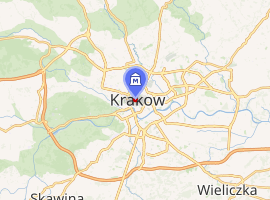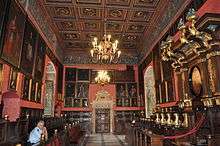Collegium Maius, Kraków
The Collegium Maius (Latin for "Great College") located in Kraków Old Town, Poland, is the Jagiellonian University's oldest building, dating back to the 14th century. It stands at the corner of ulica Jagiellońska (Jagiellon Street) and ulica Świętej Anny (St. Anne Street) near the Main Square of the historic city centre. Collegium Maius is the location of the Jagiellonian University Museum (Polish: Muzeum Uniwersytetu Jagiellońskiego), a registered museum established on the initiative of Prof. Karol Estreicher after meticulous restorations which lasted from 1949 until 1964 bringing the edifice back to its original look from before 1840.[1]
 Courtyard of the Collegium Maius National Museum | |

| |
| Established | 1949-64 (after restorations) [1] |
|---|---|
| Location | Kraków, Poland |
| Type | National Museum of Poland |
| Director | Prof Krzysztof Stopka |
| Website | http://www.maius.uj.edu.pl/ |
| Studium Generale | |

| |
| History | |
| Founder(s) | Władysław II Jagiełło Jadwiga of Poland |
| Architecture | |
| Architectural type | Polish Gothic manor |
| Completed | 1364 |
| Specifications | |
| Materials | Stone, brick and mortar |
History
The then 36-year-old first university in Poland, known at the time as Akademia krakowska (English: the Krakow Academy), moved into the building some time in the 14th century after King Władysław II Jagiełło had purchased it as an educational grant with funds bequeathed by his late wife, Queen Jadwiga.
The Collegium Maius was rebuilt in the late 15th century as a late-Gothic structure surrounding a large courtyard bordered with arcades. In 1517 a well was built in the center of the courtyard. Professors lived and worked upstairs, while lectures were held downstairs.
In the 1490s the Collegium Maius counted among its students Nicolaus Copernicus, the Renaissance astronomer and polymath who would revolutionize European ideas about the universe.
Cultural significance
The Collegium Maius Museum features lecture rooms, communal halls, professors’ quarters, a library and a treasury containing rectors' Gothic maces and the Jagiellonian globe. Exhibits also include medieval scientific instruments, globes, paintings, collectibles, furniture, coins and medals.[1]
 Stuba Communis (professors' common room) in the Collegium
Stuba Communis (professors' common room) in the Collegium Collegium Maius Assembly Hall
Collegium Maius Assembly Hall.jpg) The Old Library Chamber
The Old Library Chamber
References
- Jagiellonian University (2016), Muzeum Uniwersytetu Jagiellońskiego Collegium Maius.
